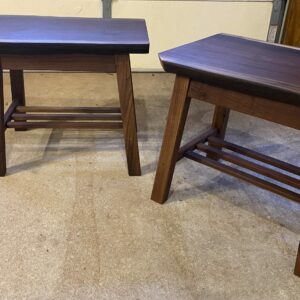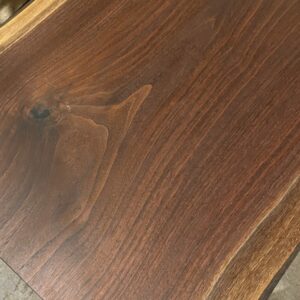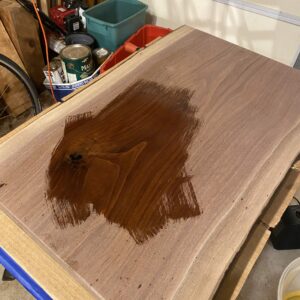I’ve used tung oil successfully for years. On the advice of a friend I diluted pure tung oil 50/50 with d-limonene citrus solvent to speed time between coats. The mix is more fluid and went on nicely. Applying to new walnut tables. Applied second coat the next day. Two issues: 1) the wood darkened considerably, much darker than previous projects with the same wood and regular “Tung Oil Finish”. 2) it is taking forever to dry, and some areas get chalky if I rub them. I’m planning to sand and refinish the table tops. Is there an easy way to fix the finish on the legs and shelf? Photos are first coat going on, and current condition.
Discussion Forum
Get It All!
UNLIMITED Membership is like taking a master class in woodworking for less than $10 a month.
Start Your Free TrialCategories
Discussion Forum
Digital Plans Library
Member exclusive! – Plans for everyone – from beginners to experts – right at your fingertips.
Highlights
-
Shape Your Skills
when you sign up for our emails
This site is protected by reCAPTCHA and the Google Privacy Policy and Terms of Service apply. -
 Shop Talk Live Podcast
Shop Talk Live Podcast -
 Our favorite articles and videos
Our favorite articles and videos -
E-Learning Courses from Fine Woodworking
-
-
 Fine Woodworking New England Event
Fine Woodworking New England Event -















Replies
If you’ve used “Tung Oil Finish” in the past it might not have had any tung oil in it at all, many don’t, it’s a marketing thing, and a sleazy one at that. Minwax brand has been said to be one of them. Others that do actually have tung oil often have polymerized tung oil which helps it dry. Most of these finishes are actually more like varnishes. Pure tung oil can take a long time to dry, and adding the citrus solvent can have unknown effects on its drying time.
If it helps, I think it looks fantastic. But like eddo234 said, Tung Oil is used as marketing hype these days.
I agree and it drives my crazy. If a company isn't transparent on their ingredients, I won't use it.
beautiful piece of walnut. Love it. Best of luck w/ the drying issue.
Save yourself some time, trouble, and expense. Chemically strip what you have done and start over using danish oil (Watco is probably the most common brand). It may darken a bit more than tung oil alone, but you won't have the same drying problems. Just follow directions on the can.
Another tried and proven mix is equal parts of tung oil (pure), mineral spirits (paint thinner), and polyurethane varnish (semi-gloss, satin, or gloss). Add a little japan drier for faster drying. Wipe it on in very thin coats.
Thanks for the advice, everyone. I heard the other day that Danish oil is actually the 3-part mix you reference. Also that it is indeed tried and true. I’m leaning towards the Danish.
If it is that tung oil is sometimes not tung but a different product, it is even more common with danish oil. The home brew recipie is 1/3 of oil, varnish and mineral spirit, personally I use linseed oil and spar varnish (alkyd) . If you purchase it already mixed, make sure you read the ingredient list, some are 100% linseed oil other contains up to 60% mineral spirit.
Is the citrus solvent water based? Someone here recently used a citrus product that was water based, and it really darkened the wood. It took a while, but it got lighter again, on its own.
I also like the color in the pictures.
Walnut also lightens as it ages.
The easiest thing to do would be to wait a week or two before doing anything and then seeing if the Tung oil has dried.
Agree, that's what I'd do, unless there's a reason you can't wait.
Well, it’s been 13 days since the second coat and it doesn’t seem to be getting any drier. A test with solvent easily removes the oil and leaves the color unchanged. Plan is: remove all the oil, leave the legs the color they are, sand the tops to bare wood. Then re-coat. Considering Danish oil or Odie’s Oil. Leaning towards Odie’s as the hard wax is said to create a more durable finish. These are side tables and will get used for glasses, cups, lamps, etc.
Odie's Oil is good w/ walnut. It will look excellent on this application. It is stupid easy to apply too and drying times are essentially very quick, although its probably best left overnight before challenging it. Expensive but worth it.
I have found its durability is good, not great, but it is to rescue - just reapply lightly over effected area.
Good to hear about Odie’s. Many people say you only need one coat. Any experience with two coats?
Odie's usually recommends two coats. I'd say call them on the line on their website, they are very helpful
What's written on the outside of the container may be deceiving. Refer to the MSDS (material safety data sheet) to get the facts on what's in the container.
SDS documents are all but useless these days.
The only ingredients that are "required" to be listed, are those that are known hazards. Most finishes don't disclose any more than they have to.
Here is Watco's Tung oil finish SDS.
https://www.rustoleum.com/MSDS/ENGLISH/266634.pdf
10-20% tung oil. (I'm betting it's more toward ten than twenty) The rest is solvents and driers.
Here are the suggested directions for Half & Half
https://www.realmilkpaint.com/shop/oils/half-and-half/?attribute_pa_size=16-oz&trueroas=17876177956
I totally agree. As a chemist in my day job, I have spent a lot of my career looking at safety data sheets. I am very disappointed with SDS for woodworking finishes for the reasons you mentioned. One of the few I think are transparent are Tried and True in terms of what is in there. I've reached the point where if I can't read the SDS and know what is in there, I won't buy it.
I've been using 100% pure tung oil followed by lacquer as a go to finish for years, especially on turnings. I also use it on furniture when I don't use General Finish Seal-A-Cell followed by Arm-R-Coat. Used Danish Oil, Tried and True, Formby's, BLO, and a bunch of other stuff in the past and never liked them, especially because you don't really know what's in the can and I need food safe finishes for turning (cutting boards, utensils, etc.) that actually protect the wood and don't get rancid.
That said, the trick with any of these, especially pure tung oil, is to put it on lightly, don't flood the surface and let it sit as per the directions on the can, then wipe off. Wipe it on sparingly. If any areas dry out immediately, wipe more on-sparingly. Then wipe off finish that's sitting on the surface, even if there doesn't appear to be any. Then I let it dry for a couple of days to a couple of weeks before hitting with lacquer. The only thing that flooding the surface with oil then wiping off the excess achieves is using up the can more quickly because most of the finish is soaked into rags or paper towels.
Only times I've run into problems and get the chalky or waxy build up after spraying is when it's humid and I've rushed the finish (it's not dry enough). I've contemplated cutting the oil with citrus solvent but want to experiment on scraps when I have the time. I do know that citrus solvent doesn't flash off like lacquer thinner or alcohol, which may be your problem.
How warm and humid is it where you're trying to let the finish dry? That could be an issue. Guess this is more insight than an answer. Beautiful tables BTW.
Thanks for the helpful comments, all. I’m certain this is what happened: I applied the tung oil/citrus solvent on day one, and applied a second coat the next day. I had been led to believe that with the solvent it dries so fast you can do that. And I was in a hurry to have them done for Thanksgiving. Ha! Well, the first coat wasn’t dry, and the second coat sealed it off from oxygen, so it stopped drying and never got any better. Ended up sanding off both coats and starting over with bare wood. A troublesome lesson learned. Re-sanded to 400 grit and applied Odies Oil. I’m happy with the look and expect good durability. For a little more sheen I’ll apply another coat and perhaps Odies butter. In fact, the look is not unlike a “Tung Oil Finish” or Danish Oil, which I like.
I know we all talk about drying, but Tung Oil (or raw Linseed oil or any 'drying' oil) doesn't dry, it polymerizes, or cures. The thinning agent, either the citrus oil or mineral spirits and the lack of oxygen in the can prevents the polymerization. When you apply it, it the thinning agents evaporate and the oil starts to polymerize by oxidation. With raw oils, this takes up to a week. With varnishes or BLO, there are 'drying agents' in the product which speed up the polymerization process to one day.
There is also "partially polymerized Tung oil". https://www.sutherlandwelles.com/ (and others) sells versions in with citrus and mineral spirits, where the cook the oil for hours at 300 degrees in the absence of O2, so it dries in a day. Others sell the "partially polymerized" versions which aren't heat treated, just have the drying agents - it's just the Tung Oil version of BLO.
In any case, don't apply a second coat until you can sand the first coat with 400 grit without gumming up the sand paper. - go through your whole finishing process with a test piece, doing this at every level. Otherwise your second coat will prevent any oxygen from getting to the first coat, which it needs to finish curing, and that first coat will take years to dry.
I learned this the hard way, I have a jewelry box I made for my wife three years ago, where I put on 4 coats of Milk Paint Tung oil that still hasn't fully cured, and never will. It holds my miscellaneous screws.
PS - I get my tung oil from Sutherland Welles (full price), they sell Gloss / Satin / Matte - I buy the Gloss and thin it (using their formulas) to Satin or Matte. I love the finish, but I'm switching from Citrus to Mineral Spirits next time because the citrus thinner costs 10 times that of mineral spirits.
On a related note, I built a table for my mother about 40 years ago and finished it with pure tung oil back then. It hasn’t had any more finish on it since that initial treatment. I want to revitalize the finish. Should I just use tung oil again? Or can I (and should I) try something else?
IMO, you'll need to sand the surface to give the new oil a "tooth" to adhere to.
A coat of 50/50, Tung oil and you're choice of solvent will work.
Thanks for the recommendation, especially about cutting the tung oil.
Use linseed oil on walnut to help maintain its initial deep color. Walnut lightens with age and can do so jarringly and fairly quickly if it gets a lot of light through a window.
Pure tung oil, if that's what you're using, goes on clearer and whiter than linseed oil, stays that way, and is not necessarily what you want on walnut.
This forum post is now archived. Commenting has been disabled